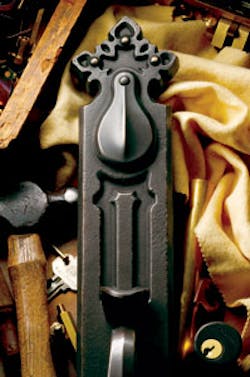Basic door lock hardware is available from a number of sources. Customers can buy standard residential style and finish doorknobs online, from a hardware store, from a big-box store or from a locksmith.
Notice how 'locksmith' came almost as an afterthought?
As a directly involved participant of this industry for over 35 years, that doesn't make me happy. I didn't mention it to make anyone happy. I mentioned it because it is a fact of life. It's a reality you must be aware of, and you can do something about it!
You have plenty of competition for the almighty sale of the common everyday doorknob. Unless you know a secret that the rest of us don't, you'll never win the sale by battling the big-box store on pricing. So don't.
The potential for increasing sales is by offering the customer something different. Decorative hardware sales exist in the other markets, but the huge chain stores can't customize their selection to meet the needs of the customer as well as most local locksmiths can. A great variety of Grade 2 and Grade 3 hardware is available to you and a lot of it is something your customer will never see or hear of unless you expose them to it.
By offering your customers a product selection they don't see at the other sources, you'll be perceived as specializing in the hard-to-find items. This, combined with some great customer service is one way to win more business.
What sells well in one neighborhood may not move at all in another. Some finishes look great but don't hold up. Most people like to have complimentary or matching hardware throughout the home.
In some cases selling new decorative hardware for the front door can bring additional sales for other doors in the house.
As far as decorative residential hardware goes, you've got a lot of choices. Most lock manufacturers have a residential line. The scope of choices will vary. Some lock manufacturers specialize in decorative hardware.
Following are four areas to think of when considering ways to increase residential decorative hardware sales. What works for you will depend on your specific customer base. It may be a combination of some of these ideas and some of your own.
SELECTION
Brands — Try selecting some variation of brands. There is an advantage with offering well-known name brands, but don't overlook the lesser-known names. If you're not sure of the quality of a brand you are unfamiliar with, ask your fellow locksmiths. You can order a sample to inspect it. Show the hardware to your co-workers to get their input.
Styles - There are some very attractive knob, lever and escutcheon designs. Glass and porcelain knobs, knurled and engraved knobs and dozens of lever styles are available. Some escutcheon plates for cylindrical and tubular locks give the appearance of old-style bit locks (skeleton key locks for you youngsters).
Functions — While entry locks are big with the home store crowd, don't overlook passage, privacy and dummy functions. As mentioned earlier, some people will see a new style they really like and want to change out the hardware on other doors in the room or all the doors in their home. Don't be afraid to mention this possibility when you're discussing hardware with the prospective customer. Remember: Sales come directly from selling.
Finishes — From flat black to bright chrome and everything in between, there are a wide choice of finishes. Consider the area your customer lives in (most bright brass hardware doesn't hold up too well near the ocean), and the type of finish. 'Lifetime' finishes are available at a higher price from some manufacturers. Antique finishes in nickel, copper and brass are popular, but not all manufacturers offer all functions in all finishes. Bright polished finishes look great when they're clean, but some tend to show fingerprints easily. Satin finishes generally hold up well, but aren't quite as decorative. Specialty knobs in plastic, glass or porcelain will still have trim rings or back plates that will be in standard finishes.
Packaging — Clear packaging or visual packs will be better for showroom stock but they may be priced higher to you than good old cardboard box packs. Depending on your displays, you may only need a few clear packs of each lock for display; then you can make the final sale in box packs. Another consideration is that boxes are easy to open, repack and close. Plastic visual packs usually have to be destroyed to get the product out, eliminating the chance of reselling the product if it is ultimately returned.
DISPLAYS
Counter/Shelf Space — The simplest displays are assembled locks displayed on a shelf, in a showcase or on top of the counter. Clear Plexiglas rings allow you to mount a lock as it would be on a door and make it fully operational. You can hand the customer a working sample so they can feel the operation of the lock.
Mounts — A block of wood representing the door is drilled and mortised to accept the sample lock. The wood is usually finished with clear lacquer, but can be painted. A working lock is mounted. Sometimes split finish locks are mounted to provide addition information. By showing the exterior in antique nickel and the interior in copper, you can demonstrate two finishes in one mount.Another idea is to use a larger piece of wood with multiple holes. Again a mixture of finishes and styles of knobs and levers can be shown in a limited area.
Floor Space — A merchandising shelf or freestanding display unit is another good idea if you have the floor space. Some can fit in a three-foot circle while others will require more room.
Wall Boards — Most shops have a lot of bare wall area in the showroom. Consider using pegboard or slat board to define an area of display. Another idea is to use one board to mount a variety of dummy knobs/levers. Group them by knob or lever styles and display all available finishes of the same style together. Make a separate board for each style. This way a customer can find a design style they like and then compare various finishes in an identical shape. It's comparing apples to apples so to speak.
Color Samples — Other than full display mounts and boards, some manufacturers produce color samples in small pieces of hardware. A ring of deadbolt faceplates in all available finishes will simply show small samples but is easy to handle and pass around.
LITERATURE
Catalogs — Decorative hardware catalogs will range from full three-ring binders to small 'sweets' catalogs. Find out what is available and make use of it. Like the wall posters catalogs are designed to raise product awareness and sell product.
Brochures — Handout brochures are helpful when a customer wants to show a spouse what new hardware they've found for the home. These small colorful pieces can help spread the word.
Flyers — Personalized flyers can focus on a specific style or design of hardware and will usually provide a blank area for your stamp or sticker.
GETTING HELP
Manufacturers — Most manufacturers will be glad to help you sell their product. Call, fax or email the company and ask them to send you any supporting literature they have. Mounted samples are usually sold, but may be free or at a reduced cost when you purchase some of their product. Some will offer free mounts, but you need to buy the hardware itself.
Some manufacturers sell direct to the retail locksmith but many sell through one or more distributors. Go online or use the Locksmith Ledger International's 2005 Security Register to find the information.
Distributors — Call your favorite locksmith distributor and ask how they can help you sell more products. After all, you are their customer. Most distributors are happy to help.
Representatives — Most manufacturers and distributors have reps. The job of the representative is to be the liaison between you and their company. Most outside sales reps will be happy to assist you or connect you with someone who can. After all, the more you sell, the more you'll buy!






